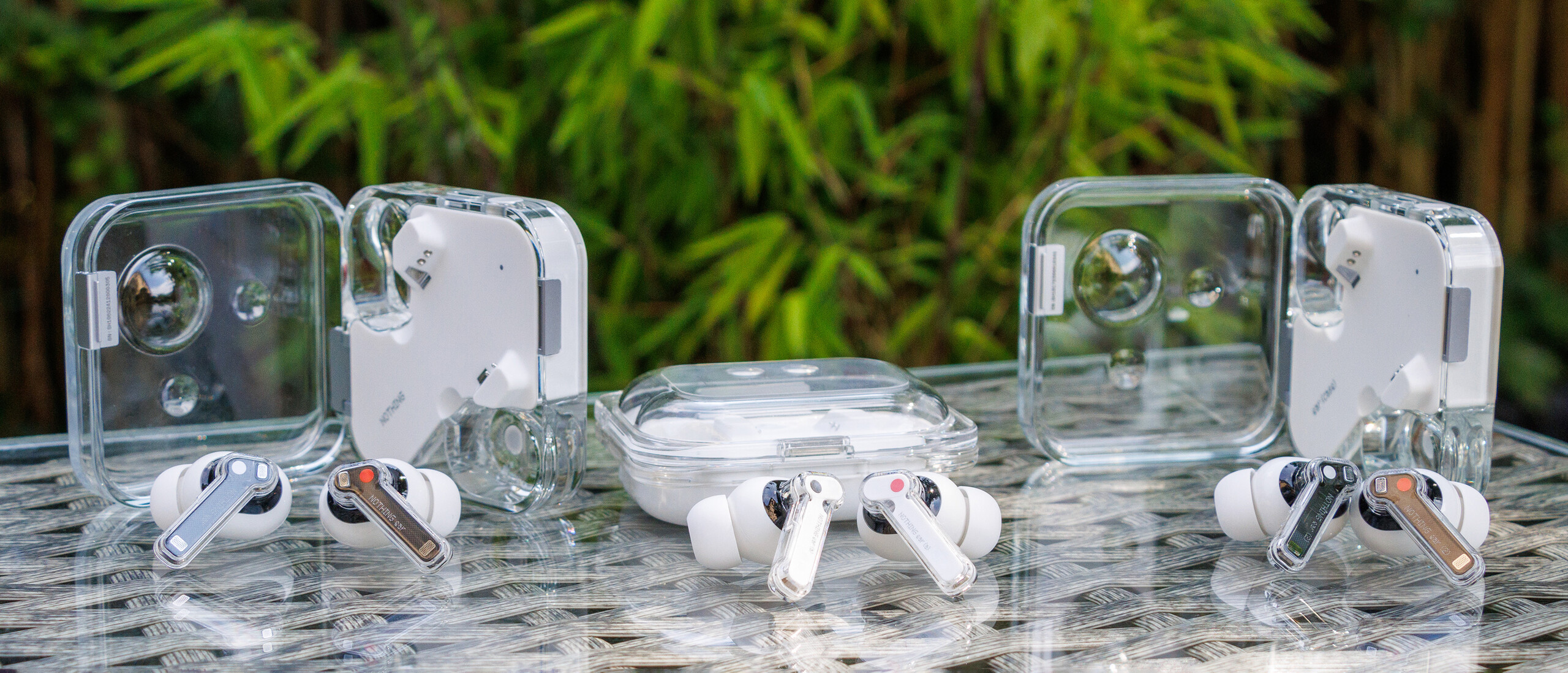
Comparison test: All of the latest wireless Nothing headphones reviewed
Nothing but sound.
Nothing doesn't just make smartphones—but also in-ear headphones, among other things. We tested all three models: the Nothing Ear (2) from last year, the top-of-the-range Nothing Ear and the more affordable Nothing Ear (a). Read this review to find out which ones are the best.Daniel Schmidt, 👁 Daniel Schmidt (translated by Daisy Dickson) Published 🇩🇪 🇫🇷 ...
The names of these TWS headphones are a little confusing, as the Nothing Ear (2) are the predecessors of the Nothing Ear. The Nothing Ear (a), on the other hand, are a more affordable model; their nomenclature is based on the manufacturer's smartphones, with the Phone (2a) marking the cheaper entry level.
While the Nothing Ear and Ear (2) have an MRSP of US$159.99, the Ear (a) will cost you US$50 less. In addition to high-res audio, all models also promise ChatGPT integration.
Specifications
| Nothing Ear | Nothing Ear (2) | Nothing Ear (a) | |
|---|---|---|---|
| Type | In-Ear | In-Ear | In-Ear |
| Connectivity | Bluetooth 5.3 | Bluetooth 5.3 | Bluetooth 5.3 |
| Reach | 10 m | 10 m | 10 m |
| Drivers | 11.6 mm ceramic | 11.6 mm graphene + PU | 11 mm PMI + TPU |
| Audio codecs | SBC, AAC, LDAC, LHDC 5.0 | SBC, AAC, LDAC, LHDC 5.0 | SBC, AAC, LDAC |
| ANC | Smart ANC, up to 45 dB | up to 40 dB | Smart ANC, up to 45 dB |
| Battery capacity | 46 mAh (headphones)500 mAh (case) | 33 mAh (headphones)485 mAh (case) | 46 mAh (headphones)500 mAh (case) |
| Charging connection | USB-C | USB-C | USB-C |
| Wireless charging | yes | yes | no |
| Certifications | IP54 (headphones)IP55 (case) | IP54 (headphones)IP55 (case) | IP54 (headphones)IPX2 (case) |
| Weight | 4.62 g (headphones)51.9 g (case) | 4.5 g (headphones)51.9 g (case) | 4.8 g (headphones)39.6 g (case) |
| Firmware version | 1.0.1.52 | 1.0.1.102 | 1.0.1.45 |
| Price (MRSP) | 149 Euro | 149 Euro | 99 Euro |
Case and ergonomics - Nothing Ears with different drivers
The Nothing Ears are all available in black and white, only the Ear (a) additionally come in yellow. All of the headphones are IP54-certified, i.e. protected against the ingress of dust in harmful quantities and against splashes of water from all sides. When it comes to their cases, the Ear (a) have to make some small compromises, as they are only protected against dripping water, whereas the more expensive models are IP55 certified.
The headphones are supplied with silicone ear tips in three sizes. The in-ears adapt well to your ear canal; to ensure an optimal fit, you can carry out a fit test via the app, which provides conclusive results. Although the earphones sit securely in your ear canal, they aren't as tight as the Jabra Elite 8 Active, for example, which is why they are only suitable for sweaty activities to a limited extent—depending on the type of sport.
If the earphones are placed directly next to each other, there is hardly any visual difference between them. This is different when it comes to their cases—even if there is still a risk of confusion with the more expensive models. However, a look at the protective grilles of the drivers reveals some differences and the materials used by the manufacturer for their drivers also differ. In this respect, the Nothing Ear (2024) feature the highest quality materials, namely ceramic.
Connectivity and operation - Clearly structured app Nothing X
Thanks to Microsoft Swift Pair and Google Fast Pair, it's super quick and easy to pair the Nothing TWS, as they are directly recognized as pairing partners by both Android and Windows. Apple users have to use a conventional pairing process. The process can be initiated manually on the case of each model. The in-ear headphones are all dual Bluetooth-capable and can therefore be connected to two devices simultaneously.
The Nothing X app is used to manage and control the TWS headphones. It is available to download from the Google Play Store and the Apple App Store, or alternatively the app can be downloaded as an APK directly from Nothing. Among other things, the app can be used to install firmware updates, set the audio codec to be used, and set predefined or custom equalizers. You can also configure noise suppression, transparency mode and the controls of the in-ears here.
One difference between the models is that the the Ear (2023) still use physical buttons, while the two newer headphones rely on touch-sensitive sensors. The controls can be customized for both sides of the earphones. It is additionally possible to use only one earbud to use the TWS as a mono headset, for example.
Wearer recognition is also on board, but this can only be switched on or off. You can optionally activate your smartphone's voice assistant by pressing the earpiece or alternatively, you can use ChatGPT. However, the latter only worked in our test if the smartphone was unlocked.
Sound - Not all Nothing-TWS have LHDC 5.0
In terms of sound, the differences in everyday use are smaller than their respective data sheets would suggest. While the Nothing Ear rely on a ceramic driver, the other two models use a lot of thermoplastic material. In addition, Nothing has removed support for the LHDC codec from the Ear (a), which means that the Personalized Sound function—which adapts the sound output to the wearer's hearing—is no longer available. The LHDC 5.0 codec is technically one of the most powerful ever and also boasts low latency. However, it should be noted that not all smartphones support it. LDAC, on the other hand, is supported by at least all reasonably modern Android smartphones; only Apple users have to make do with AAC.
The sound quality of all of these headphones is subjectively very good. Especially when Ultra Bass is activated (which the new models have), low tones are reproduced very nicely. This is simply a matter of taste. The older Ear (2) quite frankly sound more balanced and somewhat softer in this respect. The Nothing headphones all falter quickly when it comes to super high tones. All in all, however, a good sound.
| Loudspeakers | |
| THD | |
| Nothing Ear (a) (RMS: -1.8 dBFS) | |
| Nothing Ear (2) (RMS: -2.7 dBFS) | |
| Nothing Ear (RMS: -1.2 dBFS) | |
| THD+N | |
| Nothing Ear (RMS: -1.2 dBFS) | |
| Nothing Ear (a) (RMS: -1.8 dBFS) | |
| Nothing Ear (2) (RMS: -2.7 dBFS) | |
* ... smaller is better
THD (Total Harmonic Distortion): The harmonic distortion quantifies the magnitude of the components caused by non-linear distortion (harmonic content) in relation to the original signal. THD only refers to the fundamental component. The distortion factor is often mentioned in the same breath, but refers to the overall signal.
THD+N (Total Harmonic Distortion + Noise): This value is comparable to THD, but in addition to the interference power of the harmonics, that of the noise is recorded as an effective value.
For the measurement, a low-harmonic sine wave signal (1 kHz, > 0 dB) is played back via the headphones that we are testing, which is recorded by a linear measurement microphone (measurement distance: approx. 1 cm) in an artificial head.
Both values are given as a percentage. The lower the value, the better the signal fidelity.
Nothing Ear audio analysis
(+) | speakers can play relatively loud (88.9 dB)
Bass 100 - 315 Hz
(-) | nearly no bass - on average 25.1% lower than median
(+) | bass is linear (5.1% delta to prev. frequency)
Mids 400 - 2000 Hz
(±) | reduced mids - on average 8.8% lower than median
(±) | linearity of mids is average (10% delta to prev. frequency)
Highs 2 - 16 kHz
(-) | very high highs - on average 19.9% higher than median
(±) | linearity of highs is average (10.4% delta to prev. frequency)
Overall 100 - 16.000 Hz
(-) | overall sound is not linear (36.9% difference to median)
Compared to same class
» 94% of all tested devices in this class were better, 1% similar, 5% worse
» The best had a delta of 4%, average was 24%, worst was 134%
Compared to all devices tested
» 94% of all tested devices were better, 1% similar, 5% worse
» The best had a delta of 4%, average was 24%, worst was 134%
Nothing Ear (2) audio analysis
(+) | speakers can play relatively loud (92.7 dB)
Bass 100 - 315 Hz
(±) | reduced bass - on average 13.7% lower than median
(+) | bass is linear (3.6% delta to prev. frequency)
Mids 400 - 2000 Hz
(±) | higher mids - on average 9% higher than median
(±) | linearity of mids is average (7.6% delta to prev. frequency)
Highs 2 - 16 kHz
(±) | higher highs - on average 12.5% higher than median
(±) | linearity of highs is average (7.3% delta to prev. frequency)
Overall 100 - 16.000 Hz
(±) | linearity of overall sound is average (22.3% difference to median)
Compared to same class
» 64% of all tested devices in this class were better, 6% similar, 30% worse
» The best had a delta of 4%, average was 24%, worst was 134%
Compared to all devices tested
» 64% of all tested devices were better, 6% similar, 30% worse
» The best had a delta of 4%, average was 24%, worst was 134%
Nothing Ear (a) audio analysis
(+) | speakers can play relatively loud (90.8 dB)
Bass 100 - 315 Hz
(-) | nearly no bass - on average 20.1% lower than median
(+) | bass is linear (4.3% delta to prev. frequency)
Mids 400 - 2000 Hz
(±) | reduced mids - on average 7.7% lower than median
(±) | linearity of mids is average (8.6% delta to prev. frequency)
Highs 2 - 16 kHz
(-) | very high highs - on average 18.7% higher than median
(±) | linearity of highs is average (11.2% delta to prev. frequency)
Overall 100 - 16.000 Hz
(-) | overall sound is not linear (31.2% difference to median)
Compared to same class
» 89% of all tested devices in this class were better, 2% similar, 8% worse
» The best had a delta of 4%, average was 24%, worst was 134%
Compared to all devices tested
» 89% of all tested devices were better, 2% similar, 8% worse
» The best had a delta of 4%, average was 24%, worst was 134%
Battery life - The Nothing Ear 2024 have larger batteries
We carried out the runtime tests for all models with ANC activated (highest level) and used the LDAC codec. With just under six hours at an adjusted volume of 65 dB (A), the two 2024 models were on par, while the Ear (2) from the previous year ran out of steam around 80 minutes earlier, which is not surprising given their significantly smaller battery.
With the exception of the Nothing Ear (a), all of the headphones support wireless charging.
| Battery Runtime - Spotify loop at 65dB/A (incl ANC) | |
| Nothing Ear (a) | |
| Nothing Ear | |
| Nothing Ear (2) | |
Verdict - All Nothing headphones are impressive
The wireless headphones from Nothing are all great in comparison and offer a nice sound and comprehensive features within their price range.
Their sound is good, but also somewhat dependent on personal taste. High-res codecs for compatible Android devices are also supported. The two more expensive models can additionally adapt their sound to the wearer's hearing.
The Nothing Ears don't have to shy away from comparison and offer a good overall package.
The price upgrade between the Nothing Ear and the Ear (a) is justified by higher-quality materials, the additional LHDC codec, the aforementioned hearing optimization, wireless charging and a higher-certified case. If you don't need these features, you can save money by going for the Nothing Ear (a) without having to compromise on sound.
Prices and availability
| Nothing Ear | Nothing* | Galaxus* | MediaMarkt* | Amazon* |
| Nothing Ear (a) | Nothing | Galaxus* | MediaMarkt* | Amazon* |
Transparency
The selection of devices to be reviewed is made by our editorial team. The test sample was given to the author by the manufacturer free of charge for the purposes of review. There was no third-party influence on this review, nor did the manufacturer receive a copy of this review before publication. There was no obligation to publish this review. As an independent media company, Notebookcheck is not subjected to the authority of manufacturers, retailers or publishers.
This is how Notebookcheck is testing
Every year, Notebookcheck independently reviews hundreds of laptops and smartphones using standardized procedures to ensure that all results are comparable. We have continuously developed our test methods for around 20 years and set industry standards in the process. In our test labs, high-quality measuring equipment is utilized by experienced technicians and editors. These tests involve a multi-stage validation process. Our complex rating system is based on hundreds of well-founded measurements and benchmarks, which maintains objectivity. Further information on our test methods can be found here.













































